The Lost Drive-In: Marketing of the Monsters
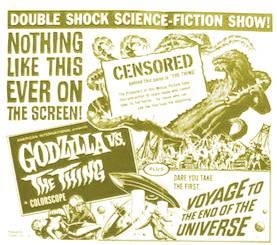
Mothra is given tentacles and blocked out by a censor stamp on the ad for Godzilla vs. The Thing.
Monster movies, especially foreign ones, have never exactly been considered high brow entertainment and are usually dismissed as fodder for a predominantly juvenile audience. No film series suffered more at the hands of American distributors than the Godzilla movies of the 60’s and 70’s. Some changes were absolutely necessary like English language dubbing but in the US the films were also subjected to severe editing, additional footage being added, major plot changes, and deceptive marketing campaigns to try and increase box office sales. This installment of The Lost Drive-In takes a look at some of the “creative” advertising used on the North American shores in attempts to broaden the appeal of Godzilla films to wider audiences.
Starting with the release of the very first Godzilla film in the US in 1956, two years after its debut in Japan, serious tampering was done to make the films more palatable to the tastes of American movie goers. The first three films, Godzilla, King of the Monsters, Gigantis the Fire Monster, and King Kong vs. Godzilla all had significant portions of the original films edited out and replaced with new scenes shot in the US and featuring American actors. Theses revisions changed the tone of the films and, in the case of Gigantis, even ignored the presence of Godzilla entirely when the distributors failed to see any value in the franchise!
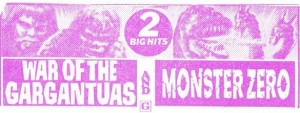
The first release of Godzilla vs. Monster Zero paired it with War of the Gargantuas.
The fourth film in the Godzilla series was the first time the giant lizard was matched up against another established Toho monster in Godzilla vs. Mothra. American International Pictures in the US figured audiences would likely laugh at a battle between a nuclear fire breathing dragon and a giant moth so changes had to be made. Mothra’s name was changed to the non-descriptive “Thing” in the title and dubbing and a deceptive ad campaign was created to match this slight of hand. The artwork depicted Godzilla as very ferocious and dragon-like while poor Mothra was completely obscured by either a censor stamp or a giant question mark that encouraged potential audience members to guess what horrible menace Godzilla would battle in the movie. While the film is one of the more enjoyable entries in the original Godzilla series, I am sure that more than a few people who paid to see it in the theater were disappointed when then on screen pay off did not live up to their imaginations.
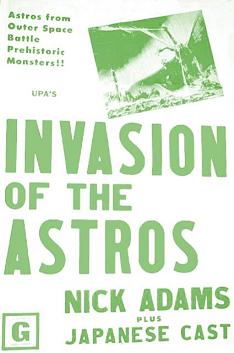
While the second release omitted Godzilla's name entirely!
Godzilla vs. Monster Zero was a perfectly acceptable, if routine, entry but it took the film five years to make to the US for theatrical distribution. This might seem like an eternity to giant monster fans but at least it made it to the big screen and wasn’t dumped straight to television like Son of Godzilla or Godzilla vs. the Sea Monster. For its first release, Monster Zero was paired up on a well structured double feature with another respectable Toho film, War of the Gargantuas. While the ads for this release may have overplayed the hype a little they were pretty typical for these types of films at the time. After this double bill had made the rounds, UPA came up with the bright idea of re-releasing Monster Zero on its own and re-titling it Invasion of the Astros and conveniently forgetting to mention any involvement from Godzilla in the ads! This could have easily lead to more than one puzzled patron realizing he had just paid to see a film he had already seen months earlier.
While it was made well after Monster Zero, 1969’s All Monsters Attack was actually released in the US first, initially paired up with the British film Island of the Burning Damned and then later with the more appropriate co-feature of War of the Gargantuas. Toho tried to take the series in a more child friendly direction with this entry and nearly ended it prematurely in the process. The story concerns a young boy who fantasizes about interacting with the various inhabitants of Monster Island to help him solve his real world problems. US distributor Maron Films decided to rename the film Godzilla’s Revenge which made absolutely no sense from a plot standpoint unless it meant what he was taking out on the audience with this movie! They also created a misleading advertising campaign that promised everything from radioactive Hell spawn to prehistoric zombies in a desperate attempt to lure in paying customers! When that tactic failed, the film was run through the more suitable kiddie show circuit where it still didn’t manage to make many fans.
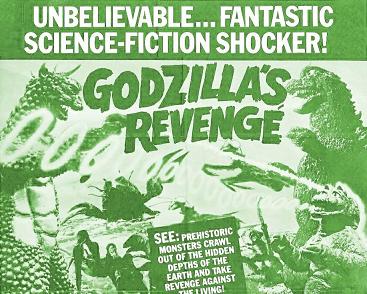
Don't even get me started on this one!
Toho took a two year vacation from Godzilla movies after the misstep with Revenge but managed to come back strong with Godzilla vs. Hedorah. This film played US theaters relatively unchanged except for a more obvious title of Godzilla vs. the Smog Monster. While AIP did respectable business with this film in the early 70’s, it was generally felt that American audiences were becoming too sophisticated for giant monsters at least, that is, until Dino De Laurentiis released his remake of King Kong in December of 1976. Godzilla films that had previously been ignored were suddenly hot commodities and small distribution companies were scrambling to get product out to theaters. This created a mid-70’s monster boom that was the last great theatrical hoorah of the genre.
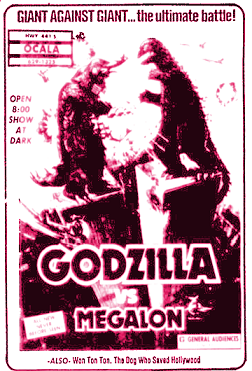
The clearly King Kong inspired ad for Godzilla vs, Megalon.
Chief among the post-Kong films was 1973’s Godzilla vs. Megalon. This rather weak entry was aimed at the television audience in Japan who were enamored with giant robots and explains the uncharacteristic presence of Jet Jaguar. What it didn’t explain was the supposed return of the monster Gigan who was the main adversary in the previous Godzilla film which had not been released in the US at this point! Advertising for the film ignored Gigan and Jet Jaguar anyway and concentrated on Godzilla and the beetle like Megalon. As a not so subtle reference to King Kong, posters and ads for the film showed the two titans squaring off on opposite sides of two buildings that looked suspiciously like the Twin Towers. Godzilla vs. Megalon has with very little to recommend it aside from some mediocre monster battles but it did well at the box office in America and encouraged distributor Cinema Shares to buy two more Godzilla films. Megalon even managed to garner a US prime time television screening less than a year later where the film was cut to under an hour to fit in a sixty minute time slot with commercials.
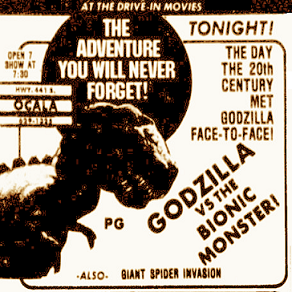
This Godzilla That Time Forgot ad proves imitation is the sincerest form of copyright infringement!
Godzilla vs. Gigan did eventually make it to US shores but it was after Megalon and re-titled Godzilla on Monster Island. The only Monster Island in the film is an amusement park under development so any notions of a possible all out monster brawl like Destroy all Monsters are dashed early on. The final Godzilla film distributed by Cinema Shares was also their most troubled. Godzilla vs. Mechagodzilla was initially released in the US as Godzilla vs. the Bionic Monster to cash in on the television popularity of shows like The Six Million Dollar Man and The Bionic Woman. The producer of those shows, Universal Television, was not amused and threatened a lawsuit if the title was not changed. The film was pulled and all uses of the word bionic were replaced by the more generic cosmic. This must have caused some initial confusion with theaters that had booked the film and couldn’t figure out what they were supposed to call it or how it was supposed to be advertised. In some areas, advertisements for AIP’s Land That Time Forgot were reworked without permission to promote this film!
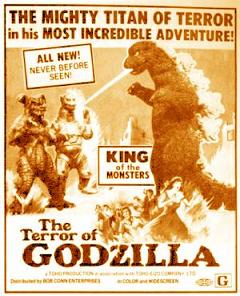
The brief theatrical release of Counterattack of Mechagodzilla under a misleading title.
The final entry in the original Godzilla film series, Counterattack of Mechagodzilla, was a direct sequel to the previous film. By the time it found its way to America in 1978, the monster craze was over and it received only a brief theatrical release under the vague title Terror of Godzilla. Posters for this version down played the monster conflict and implied some kind of path of destruction being created by Godzilla. Less than a year later, it was dumped to television under the slightly more accurate title, Terror of Mechagodzilla, with a new prolog that tried to condense the Godzilla mythos into a few minutes of screen time in an oversimplified and erroneous manner. On home video, the original US theatrical version was released with the television title retained and was later re-syndicated on television in this format. Confused yet? Just keep repeating to yourself it’s only money……..it’s only money……it’s only money!
The snack bar will be closing in fifteen minutes. Please make any last minute refreshment purchases now and thank you for visiting The Lost Drive-In.
